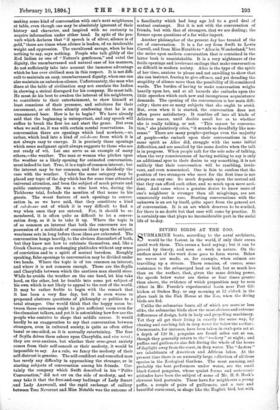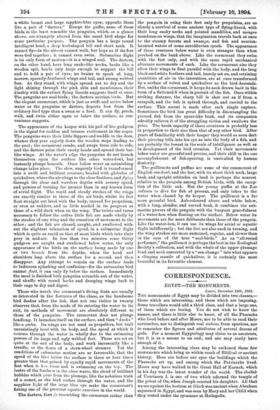DIVING BIRDS AT THE ZOO.
SUBMARINE boats, according to the naval architects, would be the fastest in the world, if only their crews could work them. This seems a hard saying ; but it can be
proved by theory, and seen at work in nature. On the surface most of the work done goes to form waves. Below no waves are made, as, for example, when salmon are travelling tip a stream. There remains, of course, some resistance to the submerged boat or bird, but so much less than on the surface, that, given the same driving power, the speeds below water are thrice or four times greater than above, the evidence of which proposition may be seen either in Mr. Fronde's experimental basin near Fort Gil- kicken at Stokes Bay, or any morning at 12 o'clock in the glass tank in the Fish House at the Zoo, when the diving birds are fed.
Unlike the submarine boats, all of which are more or less alike, the submarine birds show the most obvious and extreme differences of design, both in body and propelling machinery. Yet they all get their living in exactly the same way, by chasing and catching fish in deep water far below the surface. Cormorants, for instance, have been taken in crab-pots set at a depth of 120 ft.; penguins are found miles out at sea. though they generally return to the " rookery " at night ; and puffins and guillemots also fish during the whole of the hours of daylight away from the coast, in deep water. The " darters " are inhabitants of American and African lakes. At the present time there is an unusually large collection of all these species in the Zoological Gardens. The most amusing, and probably the best performers under water, are the small black-footed penguins, whose quaint forms and serio-comic attitudes have been the subject of some of Mr. H. S. Mark's cleverest bird portraits. These have for neighbours a young puffin, a couple of pairs of guillemots, and a rare and beautiful cormorant, in shape like the English bird, but with
a white breast and large sapphire-blue eyes ; opposite these live a pair of "darters." Except the puffin, none of these birds in the least resemble the penguins, which, as a glance shows, are strangely altered from the usual bird shape for Borne particular purpose. The penguin has a large round intelligent head, a deep keel-shaped bill and short neck. It cannot fly—in the air—it cannot walk, but hops as if its feet were tied together ; it cannot even swim. Submarine flight is its only form of motion—it is a winged seal. The darters, on the other hand, have long snake-like necks, beaks like a wooden spit, heads only large enough to support the bill and to hold a pair of eyes ; no brains to speak of, long, narrow, sparsely-feathered wings and tail, and strong webbed feet. As they stand, with wings spread out to dry and the light shining through the pink skin and membranes, their kinship with the extinct flying lizards suggests itself at once. The penguins are seal-birds ; the darters saurian-birds. But the elegant cormorant, which is just as swift and active below water as the penguins or darters, departs less from the ordinary bird type than a swan or a fowl. It can fly, perch, walk, and swim either upon or below the surface, as con- venience suggests.
The appearance of the keeper with his pail of live gudgeon is the signal for sudden and intense excitement in the cages. The penguins wave their little flippers and waddle to the door, whence they peer eagerly down the wooden steps leading to the pool ; the cormorant croaks, and sways from side to side, and the darters poise their snaky heads and spread their bat- like wings. At the water's edge the penguins do not launch themselves upon the surface like other water-fowl, but instantly plunge beneath. Once below water an astonishing change takes place. The slow, ungainly bird is transformed into a swift and brilliant creature, beaded with globules of quicksilver, where the air clings to the close feathers, and frying through the clear and waveless depths with arrowy speed, and powers of turning far greater than in any known form of aerial flight. The rapid and steady strokes of the wings are exactly similar to those of the air birds, whilst its feet float straight out level with the body, unused for propulsion, or even as rudders, and as little needed in its progress as those of a wild duck when on the wing. The twists and turns necessary to follow the active little fish are made wholly by the strokes of one wing and the cessation of movement in the other ; and the fish are chased, caught, and swallowed with- out the slightest relaxation of speed, in a submarine flight which is quite as rapid as that of most birds which take their prey in mid-air. In less than two minutes some thirty gudgeon are caught and swallowed below water, the only appearance of the birds on the surface being made by one or two bounds from the depths, when the head and shoulders leap above the surface for a second, and then disappear. Any attempt to remain on the surface leads to ludicrous splashing and confusion—for the submarine bird cannot float, it can only fly below the surface. Immediately the meal is finished both penguins scramble out of the water, and shuffle with round backs and drooping wings back to their cage to dry and digest.
Those who watch the cormorant's diving feats are usually so interested in the fortunes of the chase, as the handsome bird dashes after the fish, that not one visitor in twenty observes that, from the mode of its entering the water to its exit, its methods of movement are absolutely different to those of the penguins. The cormorant does not plunge headlong. It launches itself on the surface, and then " ducks" like a grebe. Its wings are not used as propellers, but trail unresistingly level with its body, and the speed at which it courses through the water is wholly due to the swimming powers of its large and ugly webbed feet. These are set on quite at the end of the body, and work incessantly like a treadle, or the floats of a stern-wheel steamer. Yet the conditions of submarine motion are so favourable, that the speed of the bird below the surface is three or four times greater than that gained by equally rapid movements of the feet when it his risen and is swimming on the top. The lustre of the feathers in the clear water, the cloud of brilliant bubbles which pour from the plumage, like the nebulous train of a comet, as the bird rushes through the water, and the sapphire light of the large blue eye make the cormorant's fishing one of the prettiest aquatic exercises in the world.
The darters, thou2,1 resembling the cormorant rather than the penguin in using their feet only for propulsion, are so. clearly a survival of some ancient type of flying-lizard, with their long snaky necks and pointed mandibles, and meagre membranous wings, that the imagination travels back at once to the steamy forests and swamps, and fish and saurian- haunted waters of some antediluvian epoch. The appearance of these creatures below water is even stranger than when perched on the bank above. Like the cormorant they swina with the feet only, and with the same rapid mechanical alternate movements of each. Like the cormorant also they their wings to float parallel with the body, and the long- black-and-white feathers and tail, loosely set on, and retaining quantities of air in the interstices, are at once transformed by a surface of velvet and quicksilver as the bird descends. But, unlike the cormorant, it keeps its neck drawn back in the- form of a flattened S when in pursuit of the fish. Once within striking distance, the sharp bill is shot out as if from a catapult, and the fish is spiked through, and carried to the surface. This ascent is made after each single capture. Sometimes the bird has great difficulty in disentangling the pierced fish from the spear-like beak, and its companion adroitly relieves it of the struggling victim and swallows the prize. The brain capacity of these creatures is probably less- in proportion to their size than that of any other bird. After- years of familiarity with their keeper they would as soon dart their piercing bills into his eye as into the body of a fish, and are probably the lowest in the scale of intelligence as well as in development of the bird creation. Yet their movements below water are graceful and precise, and their skill in the one accomplishment of fish-spearing is unrivalled by humank dexterity.
The guillemots and puffins are some of the commonest of English sea-fowl, and the last, with its short thick neck, large- beak, and upright attitudes on land is perhaps the nearest relative to the penguin among British birds, with the excep- tion of the little auk. But the young puffin at the Zoo refuses to dive for fish at present, and only takes to the water when chased by its keeper. The guillemot is a far more graceful bird. Ash-coloured above and white below, with a long, slender, and curved beak, it combines the sub- marine powers of the penguin with the buoyant gracefulness of a water-hen when floating on the surface. Below water its movements are far more deliberate than those of the penguin. Like the water-hen, it can use its wings for aerial or aquatic- flight indifferently ; but the feet are also used in turning, and the wing strokes are more sustained, regular, and slower than in the case of tilt true "seal-birds." As an " altround performer," the guillemot is perhaps the best in the Zoological Society's collection, and with the whole of the upper plumage head and neck converted by a" sea-change "into what appears
-
a clinging mantle of quicksilver, it is certainly the most beautiful in its favourite element.







































 Previous page
Previous page